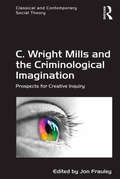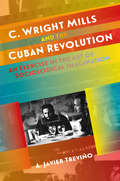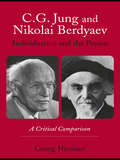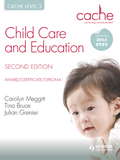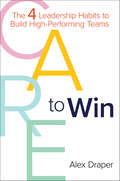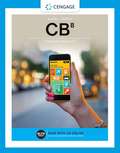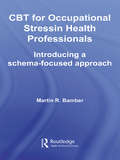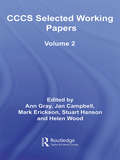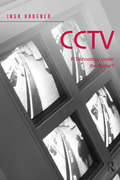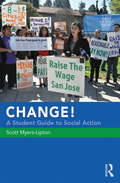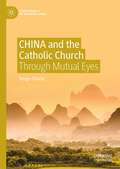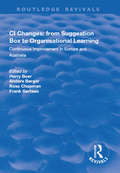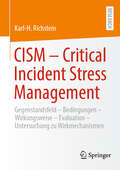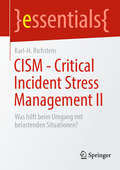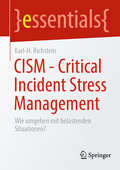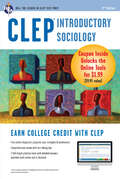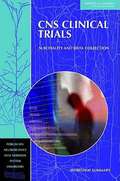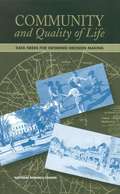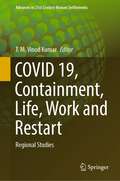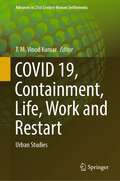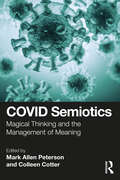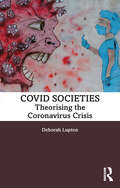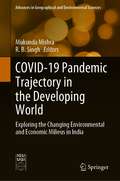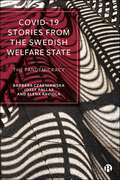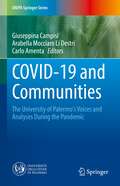- Table View
- List View
C. Wright Mills and the Criminological Imagination: Prospects for Creative Inquiry (Classical and Contemporary Social Theory)
by Jon FrauleyIn spite of its widespread use within criminology, the term ’criminological imagination’, as derived from C. Wright Mills’ classic The Sociological Imagination, has yet to be fully developed and clarified as an analytic concept capable of guiding theorizing or empirical enquiry. This volume, with a preface by Elliot Currie, engages with and reflects on this concept, exploring C. Wright Mills’ work for criminological enquiry. Bringing together the latest work of leading scholars in the fields of criminology and sociology from around the world, C. Wright Mills and the Criminological Imagination investigates the emergence and lineage of a criminological concept indebted to Mills’ thought, adapting and applying it to a specifically criminological context. With attention to theoretical concerns and, as well as the application of the criminological imagination in concrete empirical research, this volume sheds new light on the methodological and analytical aspects of the criminological imagination as a multifaceted concept and explores the possibilities that it offers for the emergence of an imaginative criminological practice. As such, it will appeal to scholars across the social sciences with interests in sociology and social theory, criminology, criminal justice studies, law and research methods.
C. Wright Mills and the Cuban Revolution: An Exercise in the Art of Sociological Imagination (Envisioning Cuba)
by A. Javier TreviñoIn C. Wright Mills and the Cuban Revolution, A. Javier Trevino reconsiders the opinions, perspectives, and insights of the Cubans that Mills interviewed during his visit to the island in 1960. On returning to the United States, the esteemed and controversial sociologist wrote a small paperback on much of what he had heard and seen, which he published as Listen, Yankee: The Revolution in Cuba. Those interviews--now transcribed and translated--are interwoven here with extensive annotations to explain and contextualize their content. Readers will be able to "hear" Mills as an expert interviewer and ascertain how he used what he learned from his informants. Trevino also recounts the experiences of four central figures whose lives became inextricably intertwined during that fateful summer of 1960: C. Wright Mills, Fidel Castro, Juan Arcocha, and Jean-Paul Sartre. The singular event that compelled their biographies to intersect at a decisive moment in the history of Cold War geopolitics--with its attendant animosities and intrigues--was the Cuban Revolution.
C.G. Jung and Nikolai Berdyaev: A Critical Comparison
by Georg NicolausThis book explores C. G. Jung's psychology through the perspective of the existential philosopher Nikolai Berdyaev, drawing striking parallels between Jung's theory of individuation and Berdyaev's understanding of the person. Placing Jung and Berdyaev firmly within the context of secular humanism, Nicolaus draws on their personal experiences of individuation to show how both writers seek to enable a renewal of our self-understanding as persons in a post-religious society. Topics of discussion include: the foundations of Berdyaev's personalism Jung's psychological interpretation of the Christian God-image individuation and the ethics of creativity. C. G. Jung and Nikolai Berdyaev: Individuation and the Person offers a fresh perspective on the ethical implications of Jung’s theory and serves also as an introduction to Berdyaev’s thought. As such this book will appeal to analytical psychologists, scholars engaged with Jungian thought and all those interested in the interface between spirituality and depth psychology.
CACHE Level 3 Child Care and Education, 2nd Edition
by Tina Bruce Carolyn Meggitt Julian GrenierExclusively published in partnership with CACHE and up-to-date with the 2012 EYFS requirements, this is the ideal textbook for you if you are taking the Award, Certificate or Diploma in the CACHE Level 3 Child Care and Education qualification.Written by a highly experienced and respected author team, this book focuses on the knowledge and skills you will need to obtain the qualification, and will support you through your assessment and the start of your career.Key features in this edition:* Up-to-date with the requirements of the revised 2012 EYFS* Focused and clear coverage from authors who are respected experts means you can trust the content and know that it is the key information that you need for the course* Case studies and Practice Tips show you exactly how you can use the knowledge and concepts when you are working* Progress Check and In Practice features make sure that you have the necessary understanding and preparation to pass your course* An easy-to-read and friendly writing style keeps the book enjoyable and accessible for all students* Key Terms features throughout the text for easy reference.
CARE to Win: The 4 Leadership Habits to Build High-Performing Teams
by Alex Draper&“Quiet quitting, hybrid workplace, toxic boss . . . How do you lead today? A good place to start is by reading this book.&” —Keith Ferrazzi, #1 New York Times–bestselling author Today, most employees stay or leave an organization because of their direct manager. Are team members provided what they need to be their best self and do their best work, or is it withheld by someone above them? Are their managers fulfilling the role of a people-first leader? Does company leadership make the working environment a psychologically safe space that maximizes both human and business performance? Some do, most don&’t—only because most aren&’t trained to. But how do leaders build high-performing, psychologically safe teams? Alex Draper, the Founder of DX Learning, has created the CARE Equation: a four-part playbook that will help leaders establish an environment employees not only feel comfortable speaking up in, but one where they want to stay at and feel like they can win in. In following the research of positive leadership and psychology, Draper&’s CARE Equation is based on the idea that when leaders provide clarity (C), give autonomy (A), build relationships (R), and establish equity (E), their teams are more likely to be psychologically safe and perform at their highest potential.CARE to Win is the much-needed modern and relevant guide for managers, their employees, and organizations. It outlines the importance of each CARE component and breaks down internal biases that keep leaders from CAREing to the fullest. Through personal stories, research, and exercises, Alex shows that when leaders CARE, everyone wins—because CARE is the human skill that gets the hard stuff done. Become the leader that sets your team up to win. Every. Single. Day.
CB
by Barry Babin Eric Harris4LTR Press solutions give students the option to choose the format that best suits their learning preferences. This option is perfect for those students who focus on the textbook as their main course resource.
CBT for Occupational Stress in Health Professionals: Introducing a Schema-Focused Approach
by Martin R. BamberThe costs of occupational stress in terms of sickness absence, ill-health-related retirement, litigation and lost productivity are increasing, putting strain on economies across the world. The fact that health care work is inherently more stressful than many other occupations makes it vital that the problem of occupational stress among health professionals is addressed. CBT for Occupational Stress in Health Professionals goes beyond simply defining the problem and fills a gap in the current literature by providing clear and concise individual treatment interventions. In three parts, the book covers: an overview of stress in the occupational context the standard CBT approach to assessment, formulation and treatment a new schema-focused approach to treating occupational stress. The schema-focused approach presented here provides powerful tools for treating a range of work-related problems for which standard CBT approaches are ineffective. Case studies are presented throughout the book to illustrate the therapeutic approaches described. This book will be of huge benefit to clinical and organizational psychologists, psychiatrists, mental health workers, counsellors and anyone else involved in treating occupational stress. It will also have much to offer those who manage people suffering from stress, human resource workers and those who are experiencing work-related stress.
CCCS Selected Working Papers: Volume 2
by Ann Gray Helen Wood Stuart Hanson Mark Erickson Jan CampbellThis collection of classic essays focuses on the theoretical frameworks that informed the work of the Centre for Contemporary Cultural Studies at the University of Birmingham, the methodologies and working practices that the Centre developed for conducting academic research and examples of the studies carried out under the auspices of the Centre. This volume is split into seven thematic sections that are introduced by key academics working in the field of cultural studies, and includes a preface by eminent scholar, Stuart Hall. The thematic sections are: Literature and Society Popular Culture and Youth Subculture Media Women's Studies and Feminism Race History Education and Work.
CCTV: A Technology Under the Radar?
by Inga KroenerCentral state and non-covert surveillance began in earnest at the start of the twentieth century. By the start of the twenty-first century, the UK was one of the most surveilled societies on earth. This groundbreaking volume by Inga Kroener analyses the particular combination of factors that have created this surveillance state. Kroener argues against the inevitability of the rise of CCTV that is so often found in this literature, to map out the early history of CCTV, tracing its development from a tool for education, safety and transport during the 1950s, to one of politics in the 1970s and 1980s, to eventually become a tool of surveillance during the 1990s. Within this analysis, the complex role of the public in 'allowing' the widespread and rapid dissemination of CCTV is discussed and the representation of CCTV in the media is also studied. This volume will be of interest to all scholars working in the fields of surveillance studies; science, technology and society departments; and social historians more generally.
CHANGE! A Student Guide to Social Action
by Scott Myers-LiptonThis is the first practical social change text devoted to students working in an academic environment. While there are many books about community organizing and social change, there are no college texts focusing on how to provide real-world experience with academic content taking into consideration the flow of the academic term. CHANGE! A Student Guide to Social Action is written specifically for faculty and staff to use with college students with the goal of helping students bring about the change they believe is necessary to make our community a better place to live.
CHINA and the Catholic Church: Through Mutual Eyes (Christianity in Modern China)
by Sergio TicozziThe volume approaches the relations between China and the Catholic Church in a quite comprehensive and unprejudiced way. Its approach is new since it clarifies the root of the persistent antagonism of both the imperial and republican Chinese Authorities toward the Catholic Church: no matter how the Catholic approach has been, they kept their Sino-centric attitude. It also points out the lack of a truly objective and complete understanding of China by the Western society, including Catholic missionaries: from a blind admiration to a negative evaluation, determined by contingent circumstances and motivations. It tries to clarify myths and stereotyped understandings, that have been created during the historical process, including the role of the Jesuits and in particular of Fr. Matteo Ricci. It also pays particular attention to the role of the Vatican in the recent religious policy of Chinese Government. The reading of the book could be enlightening especially for academics, university students and Christian clergy interested in the history of Catholic Missions in China.
CI Changes from Suggestion Box to Organisational Learning: Continuous Improvement in Europe and Australia (Routledge Revivals Ser.)
by Harry Boer Anders Berger Ross Chapman Frank GertsenThis title was first published in 2000: A consideration of continuous improvement (CI) practice and performance. It brings together the results of a survey conducted simultaneously in a number of countries, with the express intention of building up understanding of how companies throughout the world are managing the process of implementing and, perhaps more importantly, sustaining, the process of CI. In so doing, the book offers a perspective on the similarities and differences of experience in a number of countries and sheds light on possible generic problems that managers throughout the world will have to grapple with if they are to take advantage of the true potential offered by their significant investments in human resources.
CISM - Critical Incident Stress Management: Gegenstandsfeld - Bedingungen - Wirkungsweise - Evaluation - Qualitative und quantitative Studie zu Wirkmechanismen des CISM
by Karl-H. RichsteinDie in diesem Buch vorgestellte Studie zur Wirkungsweise des Critical Incident Stress Management (CISM) und deren Evaluation zeigt Einsatzmöglichkeiten des CISM als fundiertes und wirksames Instrument des Stresscopings. Die Studie wurde in Zusammenarbeit mit europäischen Airlines entwickelt, ihre Ergebnisse jedoch weisen weit über den Luftfahrtsektor hinaus. Die vorgestellten Support-Instrumente eignen sich insbesondere zur Mitarbeiterführung und nehmen als solche Verantwortung und Fürsorge zur Resilienzstärkung und Bindung von Arbeitskräften wahr. Initiale moderate Investitionen zur Implementierung eines Peer-Support-Systems amortisieren sich erfahrungsgemäß spätestens binnen eines Jahres durch abnehmende Krankenstände und sinkende Mitarbeiterfluktuation.
CISM - Critical Incident Stress Management II: Was hilft beim Umgang mit belastenden Situationen? (essentials)
by Karl-H. RichsteinDieses Buch fasst Ergebnisse einer umfangreichen Studie zusammen und beantwortet folgende Fragen: Was kann als belastende Situation erlebt werden? Was genau bedeutet „Stress“ in diesem Zusammenhang? Und was sind hilfreiche Unterstützungsangebote? Was ist ein „Debriefing“? Wie sollte es aufgebaut und durchgeführt werden? Es wird der Unterschied zu anderen Beratungsformaten geklärt, von Therapie abgegrenzt und beschrieben, wie Menschen aus einer belastenden Erfahrung gestärkt hervorgehen können.
CISM - Critical Incident Stress Management: Wie umgehen mit belastenden Situationen? (essentials)
by Karl-H. RichsteinViele Menschen erleben in ihrem beruflichen oder privaten Alltag belastende Situationen: Verkehrsunfälle, gestorbene Menschen in unmittelbarer Nähe, Überfälle, Suicide, Beinahekatastrophen. Das Buch definiert verschiedene Formen von Stress und erklärt seine Auswirkungen. Es zeigt mit der CISM-Methodik für Institutionen und Arbeitgeber auf, wie - wissenschaftlich evaluiert - darauf geantwortet werden kann.
CLEP® Introductory Sociology Book + Online (CLEP Test Preparation)
by William EgelmanEarn College Credit with REA’s Test Prep for CLEP Introductory Sociology Everything you need to pass the exam and get the college credit you deserve. REA leads the way in helping students pass their College Board CLEP exams and earn college credit while reducing their tuition costs. With 25+ years of experience in test prep for the College-Level Examination Program (CLEP), REA is your trusted source for the most up-to-date test-aligned content. Whether you’re an adult returning to finish your degree, a traditional-age college student, a military service member, or a high school or home-schooled student looking to get a head start on college and shorten your path to graduation, CLEP is perfect for you. REA’s expert authors know the CLEP tests inside out. And thanks to our partners at Proctortrack (proctortrack.com/clep), you can now take your exam at your convenience, from the comfort of home. Prep for success on the CLEP Introductory Sociology exam with REA’s personalized three-step plan: (1) focus your study, (2) review with the book, and (3) measure your test-readiness. Our Book + Online prep gives you all the tools you need to make the most of your study time: Diagnostic exam: Pinpoint what you already know and what you need to study.Targeted subject review: Learn what you’ll be tested on.Two full-length practice exams: Zero in on the topics that give you trouble now so you’ll be confident and prepared on test day.Glossary of key terms: Round out your prep with must-know vocabulary.REA is America’s recognized leader in CLEP preparation. Our test prep helps you earn valuable college credit, save on tuition, and accelerate your path to a college degree.
CNS Clinical Trials: Suicidality And Data Collection - Workshop Summary
by Institute of Medicine of the National AcademiesThe Food and Drug Administration (FDA) now requires that all clinical trials for drugs that affect the central nervous system--including psychiatric drugs--are assessed for whether that drug might cause suicidal ideation or behavior. The IOM's Forum on Neuroscience and Nervous System Disorders hosted a meeting on June 26, 2009, to discuss the FDA's new policy and how to analyze best whether suicidal thoughts predict actual suicidal behavior in the near future.
COMMUNITY and Quality of Life: DATA NEEDS FOR INFORMED DECISION MAKING
by Committee on Identifying Data Needs for Place-Based Decision Making“Quality of life” . . . “livability” . . . “sense of place.” Communities across America are striving to define these terms and to bring them to life, as they make decisions about transportation systems and other aspects of planning and development. Community and Quality of Life discusses important concepts that undergird community life and offers recommendations for collaborative planning across space and time. The book explores: Livability as an ensemble concept, embracing notions such as quality of place and sustainability. It discusses how to measure the “three legs” of livability (social, economic, ecological) while accounting for politics and personal values. And the book examines how to translate broad ideas about livability into guidelines for policymaking Place as more than location, including the natural, human-built, and social environments. The book discusses the impact of population changes over time, the links between regional and local identity, and other issues Tools for decision making in transportation and community planning. It reviews a variety of decision models and tools such as geographic information systems (GIS)—as well as public and private sources of relevant data. Including several case examples, this book will be important to planners, planning decision makers, planning educators and students, social scientists, community activists, and interested individuals.
COVID 19, Containment, Life, Work and Restart: Regional Studies (Advances in 21st Century Human Settlements)
by T. M. Vinod KumarThis book is about containment, life, work, and restart regions affected by COVID 19, using selected empirical case studies. This book presents the spread of coronavirus spatially and temporally, analyses containment strategies and includes recommended strategies. Further, it analyses how life and work get transformed during the lockdown, and gradual opening up, and presents the future of work and life in cities impacted by COVID-19. This book discusses the concept of smart life and works in cities post-COVID-19 such that they do not reduce the quality of work and life and cannot create adverse economic and living consequences called the restart of a city after COVID-19.Selected Regions of special interest are studied. Special interest is because Kerala and Maharashtra got the worst affected in India by COVID 19 pandemic and the book focus on that.
COVID 19, Containment, Life, Work and Restart: Urban Studies (Advances in 21st Century Human Settlements)
by T. M. Vinod KumarThis book is about containment, life, work, and restart cities affected by COVID 19, using selected empirical case studies. This book presents the spread of coronavirus spatially and temporally, analyses containment strategies and includes recommended strategies. Further, it analyses how life and work get transformed during the lockdown, and gradual opening up, and presents the future of work and life in cities impacted by COVID-19. This book discusses the concept of smart life and works in cities post-COVID-19 such that they do not reduce the quality of work and life and cannot create adverse economic and living consequences called the restart of a city after COVID-19.Selected Cities of special interest are studied. Special interest is because Kerala and Maharashtra got the worst affected in India by COVID 19 pandemic and the book focus on that.
COVID Semiotics: Magical Thinking and the Management of Meaning
by Colleen Cotter Mark Allen PetersonThis book examines how people around the world have articulated and shaped their experiences of COVID-19 through a sociolinguistic phenomenon known as magical thinking. Using case studies from throughout the world–China, Egypt, Europe, Jordan, Thailand, East Jerusalem, the UK, and the US–this volume looks at how people managed ambiguity and uncertainty, risk, and social isolation by viewing their experiences of the pandemic as other than, or alongside, those presented by voices and images representing scientifically derived knowledge. Each chapter in the volume introduces the reader to a core semiotic concept and shows how it can be used to analyze and unpack a specific signifying practice. In the conclusion, the several concepts from the chapters–ideological positioning, entextualization and recontextualization, double-voicing, discursive grafting, imaging, and contagion–are revisited and synthesized, in order to demonstrate that semiotics is useful not only in ethnographic studies of various “others” and of various "crises," but also in explaining the quotidian experiences of everyday life. Ultimately, this book reveals that COVID-related magical thinking practices are often as “contagious” as the virus they reimagine, spreading through social media and resulting in such social phenomena as viral videos promoting and rejecting public health practices, the first-lockdown stockpiling of toilet paper and hand sanitizer, resistance to public health recommendations, anti-vax rhetoric, and competing interpretations of emerging public health data. This book not only represents cutting-edge research in the field, but it also provides students of anthropology, linguistics, media, and communication with the vocabulary and conceptual framework to understand the human experience of the COVID-19 pandemic.
COVID Societies: Theorising the Coronavirus Crisis
by Deborah LuptonCOVID Societies presents a compelling and accessible overview of key sociocultural theories that can help us make sense of the diverse, dynamic and complex elements of the COVID crisis. These include discussions of the political economy perspective; biopolitics; risk society and cultures; gender and queer theory; and more-than-human theory. The book provides insights into everyday life around the world as people battled with containing the pandemic and explores the broader historical, social, cultural and political contexts in which these responses have developed. COVID-19 is the most serious pandemic to affect the world in the past century. We have all lived in ‘COVID societies’, the long-term effects of which have yet to be experienced or imagined. The COVID crisis has affected countries, regions within countries and social groups within regions in strikingly different ways. These impacts are continually changing, just as the novel coronavirus has mutated into different strains and variants. Throughout the book, a series of intertwined threads cross back and forth between the macropolitical and micropolitical dimensions of COVID-19: contagion, death, risk, uncertainty, fear, social inequalities, stigma, blame and power relations. Overarching these threads are five complementary themes: the historicity of COVID societies; the tension between local specificities and globalising forces; the control and management of human bodies; the boundary between Self and Other; and the continuously changing sociomaterial environments in which the world is living with and through the shocks of the COVID crisis. This book will be of great interest to anyone seeking to understand the manifold complex sociocultural consequences of the COVID-19 pandemic.
COVID-19 Pandemic Trajectory in the Developing World: Exploring the Changing Environmental and Economic Milieus in India (Advances in Geographical and Environmental Sciences)
by R. B. Singh Mukunda MishraWe are witnessing an unprecedented global outbreak of COVID-19, which has been devastating in its consequences. Beyond the acute health hazard, the pandemic has carried with it other threats for mankind associated with the human economy, society, culture, psychology and politics. Amidst these multifarious dimensions of the pandemic, it is high time for global solidarity to save humankind.Human society, its ambient environment, the process of socio-economic development, and politics and power – all are drivers to establish the world order. All these parameters are intimately and integrally related. The interconnections of these three driving forces have a significant bearing on life, space and time. In parallel, the interrelationship between all these drivers is dynamic, and they are changed drastically with time and space. The statistics serve to align the thought, based on which social scientists need to understand the prevailing equation to project the unforeseen future. The trajectory of the future world helps in planning and policymaking with a scientific direction.The practitioners of all academic disciplines under the umbrella of the social sciences need a common platform to exchange ideas that may be effective in the sustainable management of the crisis and the way forward after it is mitigated. This book provides multidisciplinary contributions for expressing the solidarity of academic knowledge to fight against this global challenge. It is crucial that there should be an on-going discussion and exchange of ideas, not only from the perspective of the current times but keeping in view the preparedness for unforeseen post-COVID crises as well.
COVID-19 Stories from the Swedish Welfare State: The Pandemicracy
by Barbara Czarniawska Josef Pallas Elena RaviolaThis book offers a unique perspective on Sweden’s COVID-19 response in its publicly funded welfare sector, which was initially highly criticised but later recognised as exemplary on the global stage in the aftermath of the pandemic. Using diaries, stories and interviews from 73 workers across 30 professions, it reveals the everyday experiences of those maintaining welfare services, both on the front lines and behind the scenes. Covering 2020 to 2022, it spans major cities and smaller municipalities across Gothenburg, Uppsala and Stockholm and introduces 'pandemicracy,' a concept exploring pandemic-era governance and organisation of the public sector. This insightful analysis sparks a wider discussion on adapting to unforeseen challenges in public welfare.
COVID-19 and Communities: The University of Palermo's Voices and Analyses During the Pandemic (UNIPA Springer Series)
by Giuseppina Campisi Arabella Mocciaro Li Destri Carlo AmentaThis volume presents an interdisciplinary reflection on the SARS-COV-2 pandemic and its consequences elaborated in real-time. It embodies the University of Palermo’s values and mission by bringing together academics of very diverse disciplinary fields on an issue that is disrupting all aspects of individual and community existence. This volume captures the voices of academics during the pandemic, allowing to crystallize the discourses that are emerging in a wide variety of scientific fields as events unfold and knowledge is rapidly evolving. They share the belief that to shed adequate light on the complex and multifaceted phenomenon of the COVID-19 pandemic and its consequences necessarily requires the adoption of an interdisciplinary approach, the consideration of a multiplicity of perspectives, and of a variety of levels of analysis. The organization of the single contributions in chapters allows the exchange of different perspectives, whilst conveying a general overall framework to the interpretation of the many facets of the changes and crisis generated by COVID-19.The volume addresses both academics and professionals dealing with the processes and the consequences brought forth by the pandemic and presents a solid example of the commitment an academic institution should devote to society and communities.
